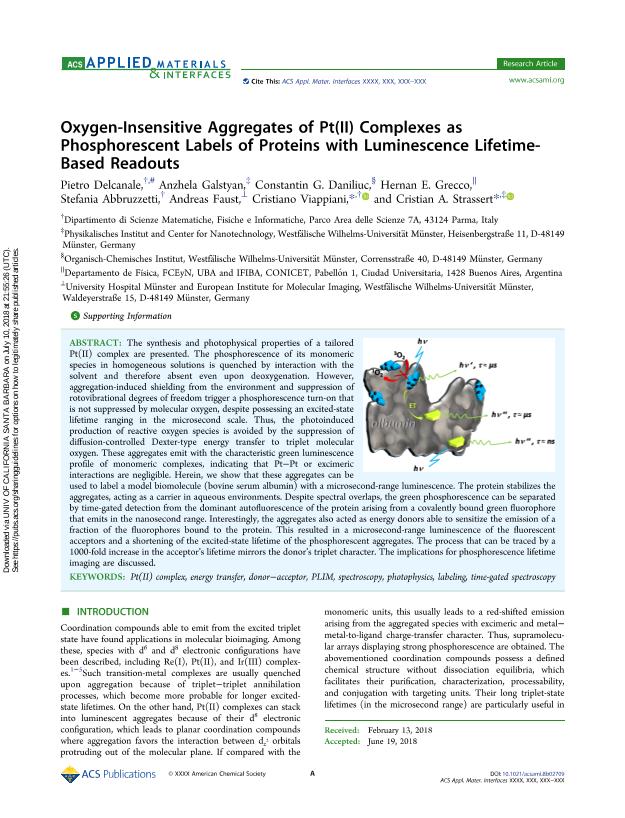Mostrar el registro sencillo del ítem
dc.contributor.author
Delcanale, Pietro
dc.contributor.author
Galstyan, Anzhela
dc.contributor.author
Daniliuc, Constantin G.
dc.contributor.author
Grecco, Hernan Edgardo

dc.contributor.author
Abbruzzetti, Stefania
dc.contributor.author
Faust, Andreas
dc.contributor.author
Viappiani, Cristiano
dc.contributor.author
Strassert, Cristian A.

dc.date.available
2020-02-05T18:22:15Z
dc.date.issued
2018-07
dc.identifier.citation
Delcanale, Pietro; Galstyan, Anzhela; Daniliuc, Constantin G.; Grecco, Hernan Edgardo; Abbruzzetti, Stefania; et al.; Oxygen-Insensitive Aggregates of Pt(II) Complexes as Phosphorescent Labels of Proteins with Luminescence Lifetime-Based Readouts; American Chemical Society; ACS Applied Materials & Interfaces; 10; 29; 7-2018; 24361-24369
dc.identifier.issn
1944-8244
dc.identifier.uri
http://hdl.handle.net/11336/96757
dc.description.abstract
The synthesis and photophysical properties of a tailored Pt(II) complex are presented. The phosphorescence of its monomeric species in homogeneous solutions is quenched by interaction with the solvent and therefore absent even upon deoxygenation. However, aggregation-induced shielding from the environment and suppression of rotovibrational degrees of freedom trigger a phosphorescence turn-on that is not suppressed by molecular oxygen, despite possessing an excited-state lifetime ranging in the microsecond scale. Thus, the photoinduced production of reactive oxygen species is avoided by the suppression of diffusion-controlled Dexter-type energy transfer to triplet molecular oxygen. These aggregates emit with the characteristic green luminescence profile of monomeric complexes, indicating that Pt-Pt or excimeric interactions are negligible. Herein, we show that these aggregates can be used to label a model biomolecule (bovine serum albumin) with a microsecond-range luminescence. The protein stabilizes the aggregates, acting as a carrier in aqueous environments. Despite spectral overlaps, the green phosphorescence can be separated by time-gated detection from the dominant autofluorescence of the protein arising from a covalently bound green fluorophore that emits in the nanosecond range. Interestingly, the aggregates also acted as energy donors able to sensitize the emission of a fraction of the fluorophores bound to the protein. This resulted in a microsecond-range luminescence of the fluorescent acceptors and a shortening of the excited-state lifetime of the phosphorescent aggregates. The process that can be traced by a 1000-fold increase in the acceptor's lifetime mirrors the donor's triplet character. The implications for phosphorescence lifetime imaging are discussed.
dc.format
application/pdf
dc.language.iso
eng
dc.publisher
American Chemical Society

dc.rights
info:eu-repo/semantics/openAccess
dc.rights.uri
https://creativecommons.org/licenses/by-nc-sa/2.5/ar/
dc.subject
DONOR-ACCEPTOR
dc.subject
ENERGY TRANSFER
dc.subject
LABELING
dc.subject
PHOTOPHYSICS
dc.subject
PLIM
dc.subject
PT(II) COMPLEX
dc.subject
SPECTROSCOPY
dc.subject
TIME-GATED SPECTROSCOPY
dc.subject.classification
Otras Ciencias Químicas

dc.subject.classification
Ciencias Químicas

dc.subject.classification
CIENCIAS NATURALES Y EXACTAS

dc.title
Oxygen-Insensitive Aggregates of Pt(II) Complexes as Phosphorescent Labels of Proteins with Luminescence Lifetime-Based Readouts
dc.type
info:eu-repo/semantics/article
dc.type
info:ar-repo/semantics/artículo
dc.type
info:eu-repo/semantics/publishedVersion
dc.date.updated
2019-10-22T18:01:21Z
dc.journal.volume
10
dc.journal.number
29
dc.journal.pagination
24361-24369
dc.journal.pais
Estados Unidos

dc.journal.ciudad
Washington DC
dc.description.fil
Fil: Delcanale, Pietro. Università di Parma; Italia
dc.description.fil
Fil: Galstyan, Anzhela. Westfalische Wilhelms Universitat; Alemania
dc.description.fil
Fil: Daniliuc, Constantin G.. Westfalische Wilhelms Universitat; Alemania
dc.description.fil
Fil: Grecco, Hernan Edgardo. Consejo Nacional de Investigaciones Científicas y Técnicas. Oficina de Coordinación Administrativa Ciudad Universitaria. Instituto de Física de Buenos Aires. Universidad de Buenos Aires. Facultad de Ciencias Exactas y Naturales. Instituto de Física de Buenos Aires; Argentina
dc.description.fil
Fil: Abbruzzetti, Stefania. Università di Parma; Italia
dc.description.fil
Fil: Faust, Andreas. Westfalische Wilhelms Universitat; Alemania
dc.description.fil
Fil: Viappiani, Cristiano. Università di Parma; Italia
dc.description.fil
Fil: Strassert, Cristian A.. Westfalische Wilhelms Universitat; Alemania
dc.journal.title
ACS Applied Materials & Interfaces

dc.relation.alternativeid
info:eu-repo/semantics/altIdentifier/doi/http://dx.doi.org/10.1021/acsami.8b02709
dc.relation.alternativeid
info:eu-repo/semantics/altIdentifier/url/https://pubs.acs.org/doi/10.1021/acsami.8b02709
Archivos asociados
